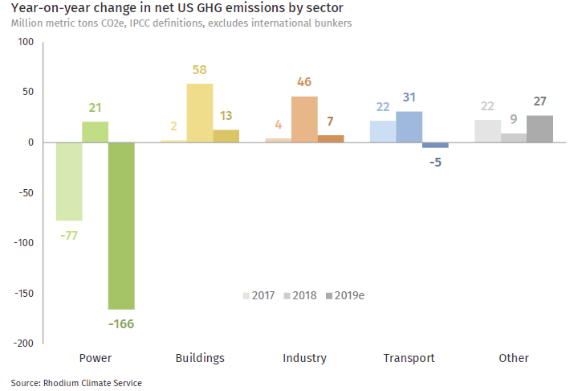Newly-released analysis from the Rhodium Group finds that U.S. greenhouse gas emissions fell by 2.1 percent last year, in contrast to 2018’s sharp uptick in emissions. Much of this turnaround can be attributed to the electricity sector, where inexpensive natural gas and cheap renewables displaced coal generation by a record 18 percent. This led to a 10 percent decline in overall power sector emissions, and marked an end to the decade where total U.S. coal generation was cut in half. Unfortunately, there is little good news outside of the power sector. Transportation sector emissions essentially remained flat, while emissions from industry, buildings, and agriculture all increased.
While the market forces driving coal retirements have a significant impact on power sector emissions, they are barely moving the needle in economy-wide emissions. Taken all together, the report shows how dangerously far away the U.S. is from a long-term pathway of emissions reductions. It is abundantly clear that comprehensive climate policy is necessary for the U.S. to move away from year-on-year emissions fluctuations, and get on a sustained path to decarbonization. An economy-wide carbon price would send a signal across all sectors of the economy that would incentivize innovation and deployment of low-carbon technology.
The results from the report highlight the difficulty of reducing emissions in sectors without low-cost clean alternatives. Cheap low-carbon alternative technologies do not currently exist for the industrial or agricultural sector, and this obstacle limits their ability to reduce emissions. Not only will a carbon price incentivize the innovative power of the market, it is uniquely capable of raising significant amounts of revenue that can be used to fund research and development of low-carbon substitutes for these hard-to-decarbonize sectors. For example, a $35 per ton carbon tax starting in 2021 would raise about $1.4 trillion in revenue by 2030. Using even a portion of that revenue for R&D on carbon capture technologies for industrial facilities, or improving fertilizer formulas would make significant strides in decarbonizing these sectors.
Where cheap low-carbon technologies do exist, a carbon price will help to deploy them at a large enough scale to drive deeper emission reductions. This price signal would encourage consumers to purchase hybrid and electric vehicles and install more energy efficient appliances in their homes. Even in the power sector, a carbon price would cement long-term emission reductions. Although natural gas did help reduce emissions in the power sector, the growth in gas generation also took a bite out of the 190 million metric tons of CO2 reduced by the drop in coal generation. As more coal retires in the coming years, a carbon price will cement the competitive advantage of renewables over natural gas, and maintain the profitability of nuclear plants across the U.S., both of which will help ensure deep decarbonization of our power sector.
It is also worth pointing out that year-on-year fluctuations in emissions follow economic trends. The report points out that strong growth in GDP in 2018 drove demand for air travel, gasoline etc., which increased emissions. Slower economic growth in 2019 reduced demand for these goods and services, and contributed to more modest emissions growth. Decoupling economic performance from emissions trends is necessary to put the U.S. on a path of sustained long-term emissions reductions, and a carbon price has the ability to drive emissions reductions without harming the economy. According to Resources for the Future’s carbon pricing calculator, by 2030, Representative Francis Rooney’s carbon tax proposal would have reduced emissions 28 percent relative to a business as usual baseline, all while growing GDP 19.2 percent over that decade. Modeling of carbon pricing bills clearly demonstrates that a carbon price can drive deep reductions in ghg emissions, without jeopardizing economic growth.
To get away from the ups-and-downs of year-to-year emissions changes, we need to have a climate policy that creates sustainable and consistent downward pressure on emissions. The sooner we adopt a carbon price, the sooner the market will align with reducing emissions, and the sooner the U.S. will be on the path to deep decarbonization.
Image by zhongguo from iStockPhotos
